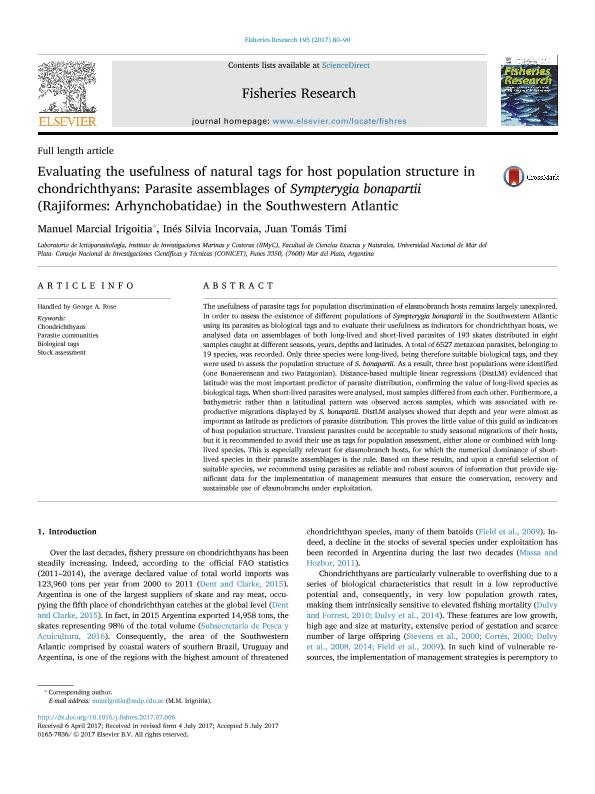Mostrar el registro sencillo del ítem
dc.contributor.author
Irigoitia, Manuel Marcial

dc.contributor.author
Incorvaia, Inés Silvia

dc.contributor.author
Timi, Juan Tomas

dc.date.available
2018-11-21T15:12:58Z
dc.date.issued
2017-11
dc.identifier.citation
Irigoitia, Manuel Marcial; Incorvaia, Inés Silvia; Timi, Juan Tomas; Evaluating the usefulness of natural tags for host population structure in chondrichthyans: parasite assemblages of Sympterygia bonapartii (Rajiformes: Arhynchobatidae) in the Southwestern Atlantic; Elsevier Science; Fisheries Research; 195; 11-2017; 80-90
dc.identifier.issn
0165-7836
dc.identifier.uri
http://hdl.handle.net/11336/64835
dc.description.abstract
The usefulness of parasite tags for population discrimination of elasmobranch hosts remains largely unexplored. In order to assess the existence of different populations of Sympterygia bonapartii in the Southwestern Atlantic using its parasites as biological tags and to evaluate their usefulness as indicators for chondrichthyan hosts, we analysed data on assemblages of both long-lived and short-lived parasites of 193 skates distributed in eight samples caught at different seasons, years, depths and latitudes. A total of 6527 metazoan parasites, belonging to 19 species, was recorded. Only three species were long-lived, being therefore suitable biological tags, and they were used to assess the population structure of S. bonapartii. As a result, three host populations were identified (one Bonaerensean and two Patagonian). Distance-based multiple linear regressions (DistLM) evidenced that latitude was the most important predictor of parasite distribution, confirming the value of long-lived species as biological tags. When short-lived parasites were analysed, most samples differed from each other. Furthermore, a bathymetric rather than a latitudinal pattern was observed across samples, which was associated with reproductive migrations displayed by S. bonapartii. DistLM analyses showed that depth and year were almost as important as latitude as predictors of parasite distribution. This proves the little value of this guild as indicators of host population structure. Transient parasites could be acceptable to study seasonal migrations of their hosts, but it is recommended to avoid their use as tags for population assessment, either alone or combined with long-lived species. This is especially relevant for elasmobranch hosts, for which the numerical dominance of short-lived species in their parasite assemblages is the rule. Based on these results, and upon a careful selection of suitable species, we recommend using parasites as reliable and robust sources of information that provide significant data for the implementation of management measures that ensure the conservation, recovery and sustainable use of elasmobranchs under exploitation.
dc.format
application/pdf
dc.language.iso
eng
dc.publisher
Elsevier Science

dc.rights
info:eu-repo/semantics/openAccess
dc.rights.uri
https://creativecommons.org/licenses/by-nc-sa/2.5/ar/
dc.subject
Biological Tags
dc.subject
Chondrichthyans
dc.subject
Parasite Communities
dc.subject
Stock Assessment
dc.subject.classification
Otras Ciencias Biológicas

dc.subject.classification
Ciencias Biológicas

dc.subject.classification
CIENCIAS NATURALES Y EXACTAS

dc.title
Evaluating the usefulness of natural tags for host population structure in chondrichthyans: parasite assemblages of Sympterygia bonapartii (Rajiformes: Arhynchobatidae) in the Southwestern Atlantic
dc.type
info:eu-repo/semantics/article
dc.type
info:ar-repo/semantics/artículo
dc.type
info:eu-repo/semantics/publishedVersion
dc.date.updated
2018-10-23T14:49:15Z
dc.identifier.eissn
1872-6763
dc.journal.volume
195
dc.journal.pagination
80-90
dc.journal.pais
Países Bajos

dc.journal.ciudad
Amsterdam
dc.description.fil
Fil: Irigoitia, Manuel Marcial. Consejo Nacional de Investigaciones Científicas y Técnicas. Centro Científico Tecnológico Conicet - Mar del Plata. Instituto de Investigaciones Marinas y Costeras. Universidad Nacional de Mar del Plata. Facultad de Ciencia Exactas y Naturales. Instituto de Investigaciones Marinas y Costeras; Argentina
dc.description.fil
Fil: Incorvaia, Inés Silvia. Consejo Nacional de Investigaciones Científicas y Técnicas. Centro Científico Tecnológico Conicet - Mar del Plata. Instituto de Investigaciones Marinas y Costeras. Universidad Nacional de Mar del Plata. Facultad de Ciencias Exactas y Naturales. Instituto de Investigaciones Marinas y Costeras; Argentina
dc.description.fil
Fil: Timi, Juan Tomas. Consejo Nacional de Investigaciones Científicas y Técnicas. Centro Científico Tecnológico Conicet - Mar del Plata. Instituto de Investigaciones Marinas y Costeras. Universidad Nacional de Mar del Plata. Facultad de Ciencia Exactas y Naturales. Instituto de Investigaciones Marinas y Costeras; Argentina
dc.journal.title
Fisheries Research

dc.relation.alternativeid
info:eu-repo/semantics/altIdentifier/url/http://www.sciencedirect.com/science/article/pii/S0165783617301807
dc.relation.alternativeid
info:eu-repo/semantics/altIdentifier/doi/https://dx.doi.org/10.1016/j.fishres.2017.07.006
Archivos asociados
